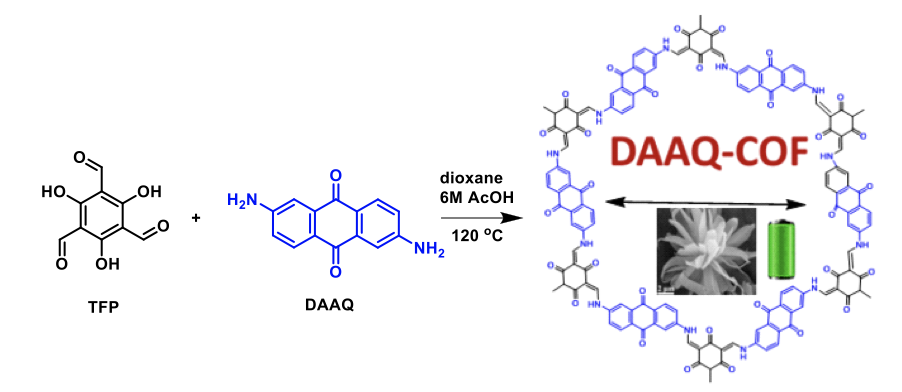Covalent Organic Frameworks (COFs)—2D/3D Crystalline Porous Materials
Covalent organic frameworks (COFs) are a class of porous polymer in which organic building blocks are precisely integrated into extended structures with periodic skeletons and ordered pores1. COFs are a new type of crystalline porous solids with well-defined two-dimensional (2D) or three-dimensional (3D) molecular structures. This places them in contrast to other types of porous material, such as zeolites, mesoporous silica, organosilica, metal organic frameworks (MOFs), carbons, and metal organic or organic cages.2 In comparison with these crystalline porous solids, COFs possess the advantages of low density, large surface area, tunable pore size and structure, facilely-tailored functionality, versatile covalent-combination of building units, and so on. COF materials have high potentials in further applications for gas storage, adsorption, optoelectricity, catalysis, and as functional devices.3
Since Yaghi and co-workers exploited the solvothermal method to achieve the first success in the COF synthesis1, many research groups have attempted to expand the synthetic possibility in different ways such as solvothermal1, ionothermal4, and microwave5 methods. The COF-LZU1 (Lan Zhou University-1)6 is one of the imine-based COFs that possesses attractive properties such as structural regularity, stability and good porosity.7 Yang et al.8 reported a simple and facile room-temperature solutionphase synthesis to fabricate a spherical COF for chromatographic separation. ACS Material offers COF-LZU1 using two synthetic methods (Type A: synthesized at room temperature and ambient atmosphere/ Type B: Solvothermal synthesis, Fig.1). The specific surface area of COF-LZU1 can be as high as 500m2/g and its pore size is only 1.2 nm. And it has been demonstrated that COF-LZU1 possesses great potential for metal coordination catalysis, bio-detection9, electrochemistry7 and so on.

Figure 1. Synthesis route of ACS Material COF-LZU1
The new chemically stable [acid and base] 2D crystalline COF-TpPa-1 was synthesized using combined reversible and irreversible organic reactions. Syntheses of the COFs were done by the Schiff base reactions of 1,3,5-triformylphloroglucinol (Tp) with p-phenylenediamine (Pa-1), in 1:1 mesitylene/dioxane.10 The specific surface area of COF-TpPa-1 in ACS Material is up to 1300m2/g, and pore size at 1.5-1.8 nm. The compound is stable even at temperatures higher than 773K, and it is applied in metal coordination catalysis, recognition of metal ions, bio-detection, chiral separation and so on.
Deblase et al.11 incorporated redox-active 2,6-diaminoanthraquinone (DAAQ) moieties into a 2D COF linked by β-ketoenamines, which were shown by Banerjee et al.12 to confer outstanding hydrolytic stability. The DAAQ-TFP COF was obtained by condensing DAAQ with TFP under solvothermal conditions (Fig.2). ACS Material offers the BET surface areas of synthesized DAAQ-TFP COF powders higher than 365 m2/g with the pore size distribution at 20Å~23Å and the compound stability at 673K. This product has potential applications in batteries and supercapacitors.

Figure 2. Synthesis route of ACS Material DAAQ-TFP COF
ACS Material Products:
- Covalent Organic Framework-LZU1 (COF-LZU1)
- Covalent Organic Framework-TpPa-1 (COF-TpPa-1)
- Covalent Organic Framework-DAAQ-TFP (DAAQ-TFP-COF)
References
1. Côté, Adrien P, et al. “Porous, Crystalline, Covalent Organic Frameworks.” Porous, Crystalline, Covalent Organic Frameworks, vol. 310, no. 5751, 18 Nov. 2005, pp. 1166–1170., doi:10.1126/science.1120411.
2. Huang, Ning, et al. “Covalent organic frameworks: a materials platform for structural and functional designs.” Nature Reviews Materials, vol. 1, no. 10, 2016, p. 16068., doi:10.1038/natrevmats.2016.68.
3. Ding, San-Yuan, and Wei Wang. “Covalent Organic Frameworks (COFs): From Design to Applications.” Chemical Society Reviews, vol. 44, no. 20, 2013, doi:10.1039/C2CS35072F.
4. Kuhn, Pierre, et al. “Porous, Covalent Triazine-Based Frameworks Prepared by Ionothermal Synthesis.” Angewandte Chemie International Edition, vol. 47, no. 18, 2008, pp. 3450–3453., doi:10.1002/anie.200705710.
5. Campbell, Neil L., et al. “Rapid Microwave Synthesis and Purification of Porous Covalent Organic Frameworks.” Chemistry of Materials, vol. 21, no. 2, 2009, pp. 204–206., doi:10.1021/cm802981m.
6. Ding, San-Yuan, et al. “Construction of Covalent Organic Framework for Catalysis: Pd/COF-LZU1 in Suzuki–Miyaura Coupling Reaction.” Journal of the American Chemical Society, vol. 133, no. 49, 2011, pp. 19816–19822., doi:10.1021/ja206846p.
7. Kong, Deying, et al. “In situ synthesis of the imine-Based covalent organic framework LZU1 on the inner walls of capillaries for electrochromatographic separation of nonsteroidal drugs and amino acids.” Microchimica Acta, vol. 184, no. 4, Aug. 2017, pp. 1169–1176., doi:10.1007/s00604-017-2095-5.
8. Yang, Cheng-Xiong, et al. “Facile room-Temperature solution-Phase synthesis of a spherical covalent organic framework for high-Resolution chromatographic separation.” Chem. Commun., vol. 51, no. 61, 2015, pp. 12254–12257., doi:10.1039/c5cc03413b.
9. Liu T, Xia J, Li Y, et al. "Preparation of Label-free C-Reactive Protein Immunosensor Based on the Palladium-coordinated Covalent Organic Frameworks(Pd/COF-LZU1) Material". Chemical Journal of Chinese Universities -Chinese Edition-, 2015, 36(10):1880-1887.
10. Kandambeth, Sharath, et al. “Construction of Crystalline 2D Covalent Organic Frameworks with Remarkable Chemical (Acid/Base) Stability via a Combined Reversible and Irreversible Route.” Journal of the American Chemical Society, vol. 134, no. 48, 2012, pp. 19524–19527., doi:10.1021/ja308278w.
11. Deblase, Catherine R., et al. “β-Ketoenamine-Linked Covalent Organic Frameworks Capable of Pseudocapacitive Energy Storage.” Journal of the American Chemical Society, vol. 135, no. 45, 2013, pp. 16821–16824., doi:10.1021/ja409421d.
12. Biswal, Bishnu P., et al. “Mechanochemical Synthesis of Chemically Stable Isoreticular Covalent Organic Frameworks.” Journal of the American Chemical Society, vol. 135, no. 14, 2013, pp. 5328–5331., doi:10.1021/ja4017842.